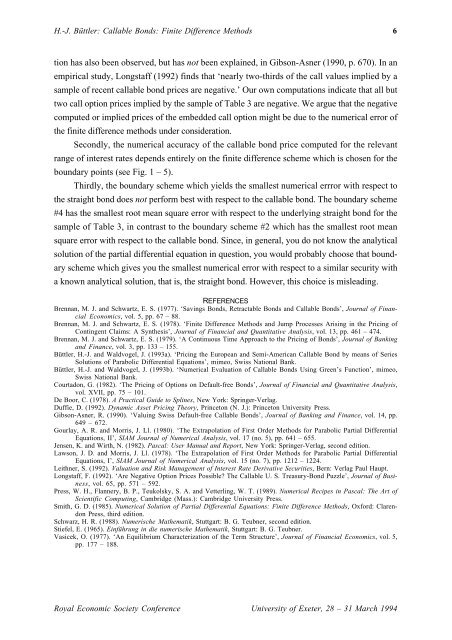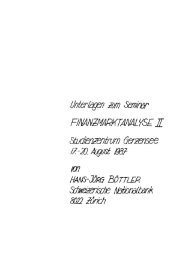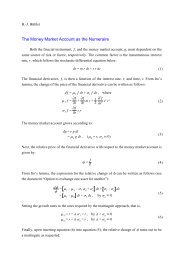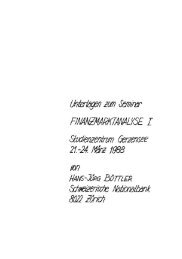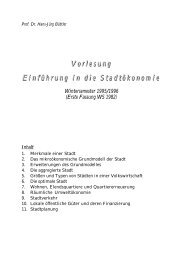Callable Bond/EJ/e
Callable Bond/EJ/e
Callable Bond/EJ/e
You also want an ePaper? Increase the reach of your titles
YUMPU automatically turns print PDFs into web optimized ePapers that Google loves.
H.-J. Büttler: <strong>Callable</strong> <strong>Bond</strong>s: Finite Difference Methods 6<br />
tion has also been observed, but has not been explained, in Gibson-Asner (1990, p. 670). In an<br />
empirical study, Longstaff (1992) finds that ‘nearly two-thirds of the call values implied by a<br />
sample of recent callable bond prices are negative.’ Our own computations indicate that all but<br />
two call option prices implied by the sample of Table 3 are negative. We argue that the negative<br />
computed or implied prices of the embedded call option might be due to the numerical error of<br />
the finite difference methods under consideration.<br />
Secondly, the numerical accuracy of the callable bond price computed for the relevant<br />
range of interest rates depends entirely on the finite difference scheme which is chosen for the<br />
boundary points (see Fig. 1 – 5).<br />
Thirdly, the boundary scheme which yields the smallest numerical errror with respect to<br />
the straight bond does not perform best with respect to the callable bond. The boundary scheme<br />
#4 has the smallest root mean square error with respect to the underlying straight bond for the<br />
sample of Table 3, in contrast to the boundary scheme #2 which has the smallest root mean<br />
square error with respect to the callable bond. Since, in general, you do not know the analytical<br />
solution of the partial differential equation in question, you would probably choose that boundary<br />
scheme which gives you the smallest numerical error with respect to a similar security with<br />
a known analytical solution, that is, the straight bond. However, this choice is misleading.<br />
REFERENCES<br />
Brennan, M. J. and Schwartz, E. S. (1977). ‘Savings <strong>Bond</strong>s, Retractable <strong>Bond</strong>s and <strong>Callable</strong> <strong>Bond</strong>s’, Journal of Financial<br />
Economics, vol. 5, pp. 67 – 88.<br />
Brennan, M. J. and Schwartz, E. S. (1978). ‘Finite Difference Methods and Jump Processes Arising in the Pricing of<br />
Contingent Claims: A Synthesis’, Journal of Financial and Quantitative Analysis, vol. 13, pp. 461 – 474.<br />
Brennan, M. J. and Schwartz, E. S. (1979). ‘A Continuous Time Approach to the Pricing of <strong>Bond</strong>s’, Journal of Banking<br />
and Finance, vol. 3, pp. 133 – 155.<br />
Büttler, H.-J. and Waldvogel, J. (1993a). ‘Pricing the European and Semi-American <strong>Callable</strong> <strong>Bond</strong> by means of Series<br />
Solutions of Parabolic Differential Equations’, mimeo, Swiss National Bank.<br />
Büttler, H.-J. and Waldvogel, J. (1993b). ‘Numerical Evaluation of <strong>Callable</strong> <strong>Bond</strong>s Using Green’s Function’, mimeo,<br />
Swiss National Bank.<br />
Courtadon, G. (1982). ‘The Pricing of Options on Default-free <strong>Bond</strong>s’, Journal of Financial and Quantitative Analysis,<br />
vol. XVII, pp. 75 – 101.<br />
De Boor, C. (1978). A Practical Guide to Splines, New York: Springer-Verlag.<br />
Duffie, D. (1992). Dynamic Asset Pricing Theory, Princeton (N. J.): Princeton University Press.<br />
Gibson-Asner, R. (1990). ‘Valuing Swiss Default-free <strong>Callable</strong> <strong>Bond</strong>s’, Journal of Banking and Finance, vol. 14, pp.<br />
649 – 672.<br />
Gourlay, A. R. and Morris, J. Ll. (1980). ‘The Extrapolation of First Order Methods for Parabolic Partial Differential<br />
Equations, II’, SIAM Journal of Numerical Analysis, vol. 17 (no. 5), pp. 641 – 655.<br />
Jensen, K. and Wirth, N. (1982). Pascal: User Manual and Report, New York: Springer-Verlag, second edition.<br />
Lawson, J. D. and Morris, J. Ll. (1978). ‘The Extrapolation of First Order Methods for Parabolic Partial Differential<br />
Equations, I’, SIAM Journal of Numerical Analysis, vol. 15 (no. 7), pp. 1212 – 1224.<br />
Leithner, S. (1992). Valuation and Risk Management of Interest Rate Derivative Securities, Bern: Verlag Paul Haupt.<br />
Longstaff, F. (1992). ‘Are Negative Option Prices Possible? The <strong>Callable</strong> U. S. Treasury-<strong>Bond</strong> Puzzle’, Journal of Business,<br />
vol. 65, pp. 571 – 592.<br />
Press, W. H., Flannery, B. P., Teukolsky, S. A. and Vetterling, W. T. (1989). Numerical Recipes in Pascal: The Art of<br />
Scientific Computing, Cambridge (Mass.): Cambridge University Press.<br />
Smith, G. D. (1985). Numerical Solution of Partial Differential Equations: Finite Difference Methods, Oxford: Clarendon<br />
Press, third edition.<br />
Schwarz, H. R. (1988). Numerische Mathematik, Stuttgart: B. G. Teubner, second edition.<br />
Stiefel, E. (1965). Einführung in die numerische Mathematik, Stuttgart: B. G. Teubner.<br />
Vasicek, O. (1977). ‘An Equilibrium Characterization of the Term Structure’, Journal of Financial Economics, vol. 5,<br />
pp. 177 – 188.<br />
Royal Economic Society Conference University of Exeter, 28 – 31 March 1994


